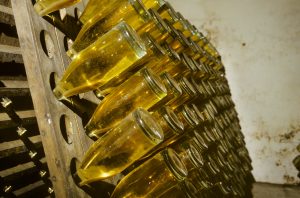The subtleties of Pinot Meunier
Champagne equals premium price, right? Well – in many cases – yes, you do have to pay significant money for a bottle of that fizz, but there are examples that are far less damaging to our bank accounts and there is a silent hero that makes it possible. Its name is Pinot Meunier.

What makes Pinot Meunier special?
Pinot Meunier is one of three classic varieties of Champagne, with the other two being Chardonnay and Pinot Noir. These two are responsible for some of the finest wines the region can offer, but growing those capricious varieties in the challenging environment of Champagne comes at cost. Climate of Champagne can be very cold and the spring frosts that come around March every year can cause dramatic damage to the prospect yields. These sudden drops in temperature can damage buds, which in next weeks could transform into flowers that after pollination would turn into the fruit. Vines that release buds early like Chardonnay and Pinot Noir are at the biggest risk. These two varieties also need favourable spots on the hills that will secure good drainage and water holding balance. Next, they grow best on pockets of lighter soils with limited availability like chalk, limestone, and marl, that will allow fruit to retain high acidity and keep pH low. Finally, their yield must be strictly controlled as they easily lose quality with higher crops.

Pinot Meunier on the other hand is a much sturdier variety. It strategically avoids risk of spring frost by budding a bit later than the other two varieties, making it a more reliable crop! As it thrives on heavier soils, it does not have to compete for land with Chardonnay or Pinot Noir and will successfully grow on clay – soil on which other two varieties struggle to give a crop of satisfactory quality. And then, it can yield more fruit than Chardonnay and Pinot Noir without damaging its quality. All that contributes to lower prices producers are paying to growers and what then translates to a more wallet friendly final product.
Taste wise, Pinot Meunier brings more lush, riper fruit that is suitable for early drinking style wines. Chardonnay, for comparison, gives more austere, citrus driven and very high acidic juice that needs longer lees ageing to attain elegance and complexity.

The time does it magic
What makes Champagne outstanding from other sparkling wines, beside exceptional fruit quality, is the tradition of extended lees ageing. This not only adds a delicious doughy and biscuity layer but also polishes off the very high and sharp acidity of Chardonnay. In other words, wines made with only this variety most often must spend some time on lees, to not only be palatable (unless you enjoy an almost heartburn-causing ultra-high acidic drinks!), but also to gain appropriate complexity. Long ageing, of course, also adds cost in production and therefore resulting in higher price for the final product. Alternatively, we have Pinot Meunier, which has naturally lower acidity that doesn’t need tempering and therefore is earlier ready for drinking. It will still be aged on lees to get all the yeasty delicacies, but the whole process, while still being considered extended compared to other sparkling wines, will take less time than the wait for the acidity of Chardonnay to get smoothed out. So, again, shorter ageing equals a more approachable price point for Pinot Meunier based Champagnes!
Worth remembering that around 90% of Champagne is non-vintage, early drinking style. Pinot Meunier, with all its attributes described above, works perfectly in this style. Most often it takes a minor part in blends with the main act being Chardonnay and Pinot Noir or just with Pinot Noir in Blanc de Noir style.
How else can Pinot Meunier be used?
So, we discussed the pros of Pinot Meunier in early-drinking Champagnes. But how does it fit in other styles?
Vintage and Special Cuvees – Pinot Meunier is rarely used here as it often lacks appropriate acidity and quality that Chardonnay and Pinot Noir can deliver.
Single Varietal – with not enough acidity, it is hard for Pinot Meunier to pull off the whole wight on its own. However, when the vintage is favourable, and fruit comes from vines from best spots, then some producers manage to make single varietal Pinot Meunier.
Rose – Pinot Meunier may be added to bring a layer of lush fruit and floral notes to the aroma and flavour.
Blanc de Noir – if it is an early drinking Blanc de Noir, blending Pinot Meunier with Pinot Noir gives delicious results!
Champagnes with Pinot Meunier worth a try!

Jean de la Fontaine Champagne Brut NV – 70% Pinot Meunier in the blend (plus Chardonnay 20%, 10% Pinot Noir)
https://corksofbristol.com/product/baron-albert-cuvee-jean-fontaine-nv

Bernard Robert Champagne Brut NV – 20% Pinot Meunier in the blend (plus Pinot Noir 60%, Chardonnay 20%)
https://corksofbristol.com/product/bernard-robert-brut-reserve-nv/
Happy drinking!
Marek